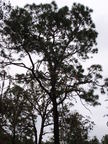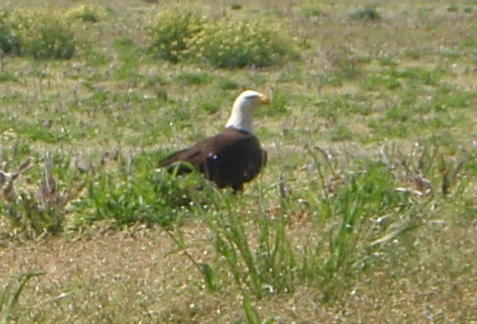No pesticides: hand weeding. More than seven feet tall.
Picture by Gretchen Quarterman, Lowndes County, Georgia, 30 Sep 2010.
-jsq
That’s right, the nine foot tall longleaf I’m holding is only three years old. They told us they would never grow without spraying. But we weeded these trees with hoes and gloves, and here they are.
Picture of John S. Quarterman with trees by Gretchen Quarterman, Lowndes County, Georgia, 2 July 2010.
 The surprising thing is so few people have heard of Leon Neel.
Here’s a very interesting biography of this very influential
pioneer in southeastern forestry and agriculture, including
many interesting stories of south Georgia and north Florida
life and politics:
The surprising thing is so few people have heard of Leon Neel.
Here’s a very interesting biography of this very influential
pioneer in southeastern forestry and agriculture, including
many interesting stories of south Georgia and north Florida
life and politics:
The Art of Managing Longleaf:Leon Neel was a atudent, apprentice, and successor of Herbert Stoddard, who was originally hired by quail plantation owners around Thomasville to figure out why their quail populations were decreasing. The answer included a need to thin and especially to burn their longleaf pine tree forests. Stoddard and Neel studied and practiced for almost a century between them on how to preserve and increase the amount of standing timber and species diversity while also selectively harvesting trees to pay for the whole thing. Their Stoddard-Neel Approach is written up in textbooks. In this book we learn how it came about, and how it is basically different from the clearcut-thin-thin-clearcut “efficient” timbering cycle that is the current fad among pine tree growers in the southeast.
A Personal History of the Stoddard-Neel Approach,
by Leon Neel, with Paul S. Sutter and Albert G. Way.
It starts back in the old days of Leon Neel’s youth when his daddy taught him to hunt quail: Continue reading
Chamaecrista fasciculata, showy partridge pea, planted as part of the Conservation Reserve Program (CRP) that includes along with longleaf pine trees some Native Warm Season Grasses (NWSG) and partridge pea.
Little bluestem, partridge pea, and longleaf: Continue reading
 With appearances by
Moody Forest and people from there and from the
Longleaf Alliance, not to mention
gopher tortoises and indigo snakes:
With appearances by
Moody Forest and people from there and from the
Longleaf Alliance, not to mention
gopher tortoises and indigo snakes:
Fire forest, yes! But they forgot to mention Smilax: catbriar, greenbriar, those vines that like to catch you in the woods.
Thanks to Gary Stock for the tip.
-jsq
 Looking for Longleaf: The Fall and Rise of an American Forest,
by Lawrence S. Earley
Looking for Longleaf: The Fall and Rise of an American Forest,
by Lawrence S. Earley
The tallest and strongest of pine trees, longleaf made great sailing ship masts , tar for caulking ships, and of course saw timber. How the early settlers cut down trees for houses and to clear land to farm. Their hogs and cows running loose in the woods ate the young longleaf, suppressing new trees for a hundred years. Then professional forestry took over, trying to suppress the fire that destroyed northern white pine forests, yet which preserves southern longleaf pine forests. The sad story of turpentine: we knew better, but we did it anyway.
The peculiar life cycle of a tree that starts out looking like a clump of grass, and can stay that way for decades, yet promotes and survives fire and can grow more than 100 feet tall and live for centuries. The thousands of species of plants, animals, and fungi the forest protects, many of them, like wiregrass, also adapted to fire.
How tuberculosis and quail led to new understandings of longleaf and fire, and the people who discovered those things. We do know how to grow these trees now, and lots of people are doing it: for jobs, for sawtimber, for the beauty of the forest.
I was going to start by posting a short list, but each item was turning into a review, so I’ll just post them one by one as reviews.
 Ecology of a Cracker Childhood (The World As Home),
by Janisse Ray.
Ecology of a Cracker Childhood (The World As Home),
by Janisse Ray.
How dirt poor crackers and corporate greed destroyed most of the most diverse ecosystem in North America; yet these same people are the tragic heroes of the book. Half autobiography, half ecology, this book will either get you with Janisse’s “stunning voice” or you won’t get it. If you’re from around here, you’ll hear the wind in the pines, feel the breeze, and see the summer tanagers yellow in the sun. If you’re not, here’s your chance to meet a “heraldry of longleaf” up close and personal.
“I will rise from my grave with the hunger of wildcat, wings of kestrel….”See Janisse read in Moultrie. “More precious than handfuls of money.” See her wikipedia page for a pretty good bio.
But read the book.
 If nothing else, you’ll never think the same again about Amazon
deforestation once you realize we already did that to ourselves,
and in the south we live in the devastated remnants of what was
one of the most extensive forests on earth, with longleaf pine trees
100 feet tall and 500 years old, maintained by fire, protecting everything from the Lord God bird to the lowly Bachman’s sparrow, from the rattlesnake-eating indigo snake to the beetles that live in gopher tortoise burrows.
The forest can return,
because reforestation can pay.
Meanwhile, there are still places
where you can see how it used to be.
Janisse Ray had a lot to do with preserving Moody Forest, too,
but that’s another story.
If nothing else, you’ll never think the same again about Amazon
deforestation once you realize we already did that to ourselves,
and in the south we live in the devastated remnants of what was
one of the most extensive forests on earth, with longleaf pine trees
100 feet tall and 500 years old, maintained by fire, protecting everything from the Lord God bird to the lowly Bachman’s sparrow, from the rattlesnake-eating indigo snake to the beetles that live in gopher tortoise burrows.
The forest can return,
because reforestation can pay.
Meanwhile, there are still places
where you can see how it used to be.
Janisse Ray had a lot to do with preserving Moody Forest, too,
but that’s another story.
-jsq
 Olivia Judson writes about
Divide and Diminish:
Olivia Judson writes about
Divide and Diminish:
A different process goes on when an island forms by splintering. Here, the ecosystem is pre-existing: the island is created with a set of residents already in place. But it is now too small to support them all.She’s not talking about prescribed forest burns, which are actually necessary for longleaf pine forest ecology. She’s talking about burns that destroy forests.What happens next is a kind of unraveling, a fraying, a disassembling such that the ecosystem becomes simpler, so as to fit the space that is now available. On those recently-created islands of Indonesia, for example, the smallest islands are home to many fewer species than the largest islands. And, as you’d expect, you don’t find big animals on the smallest islands either.
When we humans burn tracts of forest, or make islands in some similar way, the immediate impacts depend on a suite of factors, including how many islands there are, how big they are, and how close they are together. It also matters what is between them. Fields may be more hospitable to wildlife than roads or water; under some circumstances, life forms may be able to flit from one fragment to another, and the “island” nature of the fragments will be reduced. Perhaps we can use such patterns to shape how we use land, to try and minimize the impact we have.
Perhaps.
The once-mighty longleaf pine ecology that spread from eastern Virginia to east Texas now only exists in tiny islands separated by cities, fields, and roads. Maybe we should preserve the few patches that are left. This isn’t just about plants and animals, you know, it’s also about flood control, food supply, and living conditions.
Half a century ago we overused pesticides, in particular DDT, which caused birds’ eggs to become too fragile. Bald eagles vanished from many places. But sometimes they come back, when we stop poisoning them and instead save some habitat.
The eagle pictured was just sitting beside the road as we drove by. There are more in nearby counties. Picture by Gretchen Quarterman, 23 March 2010.
Here’s what they look like just after they come up:
It’s a pretty big tree: Continue reading